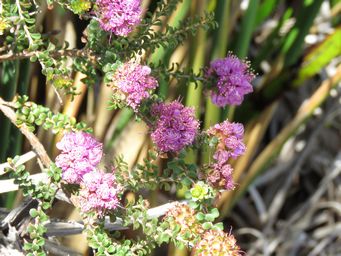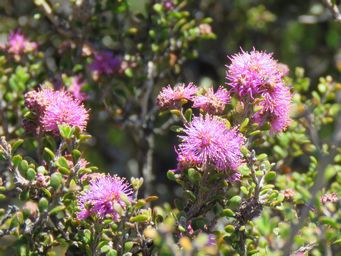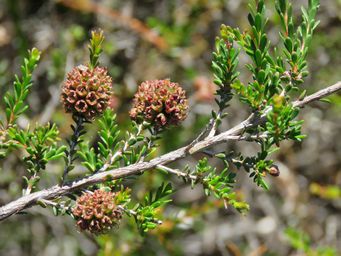Australia So Much to See
Copyright (C) 2013 AustraliaSoMuchtoSee.com. All reights reserved
Sources used for identification of wildflowers including Aboriginal names shown on these pages, and regions where they occur, are
listed under Credits
These pages will feature some of the wildflowers we have photographed in Western Australia,
and where possible, identified. If you are able to help identify further flowers, or correct any I may have wrong, please contact
us.
Information given for each species will give botanical name, known common names, describe the flower, give time of year it
was seen, where it was photographed, and the areas it occurs in. Names have been matched to Florabase which has also been
used to show distribution.
See some of these wildflowers in larger sized photos on our Flickr pages.
Keraudrenia is now known as Seringia and can be seen under S
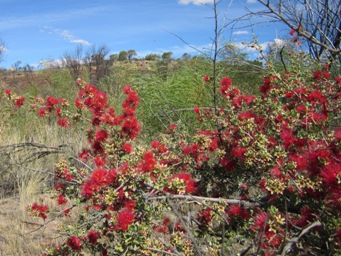
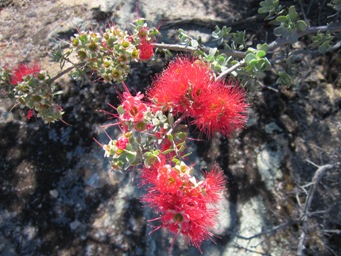
Kunzea pulchella Granite Kunzea
Usually bright red, with a fluffy flower which has one stamen, on a small shrub. White variation
at right seen north of Coolgardie.
Spring
Talgomine Rock near Nungarin in the Wheatbelt region Western Australia and occurs on and near
granite outcrops throughout the Wheatbelt and into the Goldfields

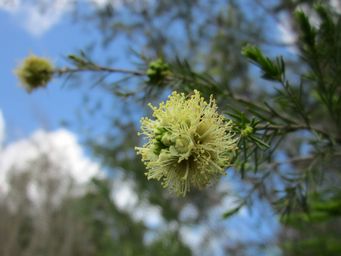
Kunzea glabrescens, Spearwood and Kunzea ericifolia is very similar
A tall growing shrub with upright branches (these have been pulled
down to photograph). Old cones alongside developing flowers at right.
Spring
Bridgetown, South West region Western Australia
and occurs in the South West and adjacent wheatbelt, around Perth, the coastline north to Cervantes, and in the lower Great Southern
to Albany.
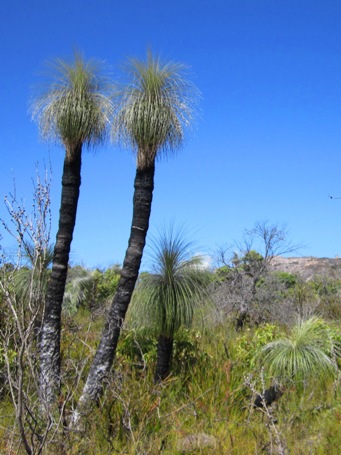

Kingia australis, Bullanock, Bullonock, Waiyu, Kingia. Kingia australis is the only Kingia in the genus
A grass tree which grows
tall and slender with blackened trunk, and has needle like leave similar to Xanthorrhoea. Flowers come as a cluster of pompoms.
The photo above shows rapid regeneration with a mass of flowers after a severe wildfire. Kingias can grow to six metres in height.
Photo
of developing flowers taken in March but they usually flower in winter
Northcliffe (above), South West region, Western Australia, and
found in areas in the coastal strip from Albany to Perth, with occasional colonies being found further north. At left shows the
silvery young foliage of the slender Kingias of the south coast
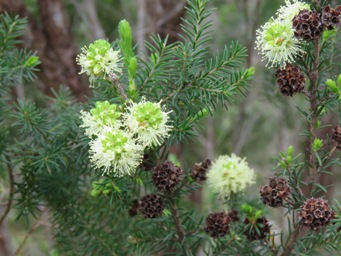
Kunzea micrantha
A small shrub which grows to 1.5 to 2 metres. Rounded cluster blooms on the ends of the stems, mostly pink but can
vary to white or purple. Elongated small oval leaves alternating along the stems, with just some curving back.
Similar
to Kunzea recurva which has broader and recurving foliage.
October November
Seen at Tonebridge and Heartlea, Boyup Brook shire,
and near Yornup in the southern Bridgetown-Greenbushes shire, South West region, Western Australia. Favouring, winter wet depressions,
found in areas mostly westwards if a line from Geraldton to Albany with occurrences in adjacent parts of the Wheatbelt and along the
south coastal strip to Ravensthorpe.

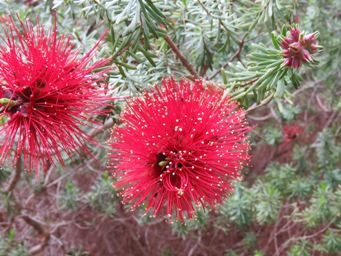
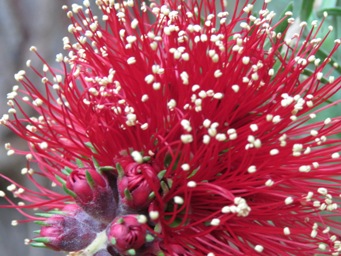
Kunzea baxteri, Baxters Kunzea, Crimson Kunzea, Scarlet Kunzea
A red bottlebrush flower on a shrub which can reach four metres in height. Fine elongated leaves are a soft bluish green
Spring although can flower in other months
Found in bushland well outside the original
area, probably from dumping of garden prunings in the bush. Occurs naturally mainly near the south coast around Esperance, southern
Goldfields region, Western Australia, but garden plantings and subsequent escape has probably distributed to it being found in many
other areas.
Kunzea recurva
There are a number of natural hybrids from Kunzea recurva crossed with other species.
Rounded cluster blooms on
the ends of the stems, mostly pink but can vary to white or purple. Leaves alternating along the stems are heart shaped,
or egg shaped to a point which curves back. Leave stems are very short. Shrubs are mostly short but can reach two metres.
Similar to Kunzea micrantha.
December and can flower from August through to December.
Seen at Northcliffe, and found from Bindoon
north of Perth, through the Perth Peel region, the South West and Great Southern, in parts of the south west Wheatbelt, and into the
south western Goldfields in the Fitzgerald River national park near Ravensthorpe.
